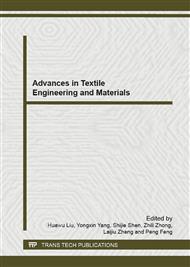p.869
p.873
p.878
p.885
p.892
p.896
p.903
p.907
p.912
Fabrication and Mechanical Properties Analysis of Flame-Retardant Fiberboards Made of Abandoned Flax Fibers and Polyurethanes
Abstract:
In this paper, abandoned flax fibers were adopted as reinforcing materials, polyurethane particles were adopted as matrix materials. Through blend mastication and hot-pressing methods to exploit flame-retardant fiberboards, which were made of abandoned flax fibers and polyurethanes. This paper explored the mechanical properties and flame-retardant property.Tensile strength, bending strength and impact strength were selected as mechanical properties' test index, limiting oxygen index was selected as flame-retardant property's test index. Abandoned flax fibers mass fraction, hot-pressing temperature, hot-pressing time and flame-retardant mass fraction acted as level of factor. The optimized processing conditions were concluded through orthogonal experiment and the range analysis: abandoned flax fibers mass fraction 45%, hot-pressing temperature 170°C, hot-pressing time 6 min, flame-retardant mass fraction 10%. This paper studied the solution of the abandoned fibers’ reuse. At the same time, it provided theoretical guidance for the further development of flame- retardant polyurethane fiberboard.
Info:
Periodical:
Pages:
892-895
Citation:
Online since:
December 2012
Authors:
Price:
Сopyright:
© 2013 Trans Tech Publications Ltd. All Rights Reserved
Share:
Citation:


